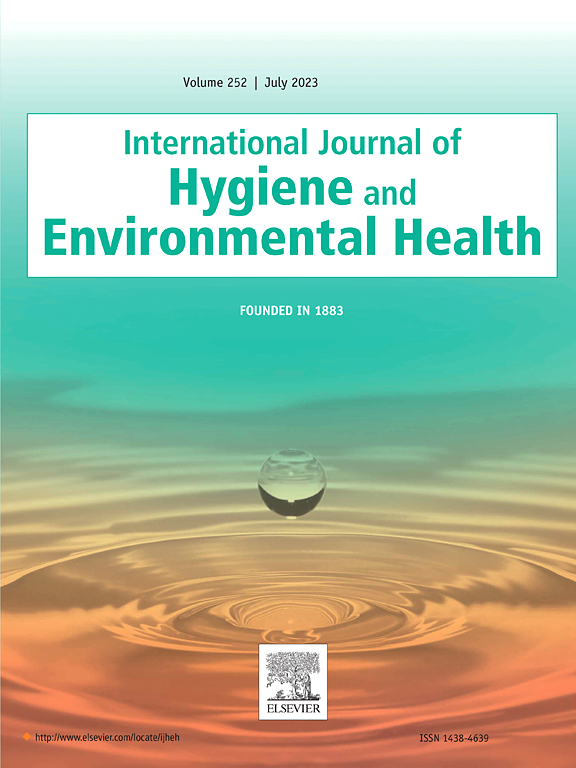Dietary exposure to environmental phenols and phthalates in Korean adults: data analysis of the Korean National Environmental Health Survey (KoNEHS) 2018–2020
IF 4.4
2区 医学
Q1 INFECTIOUS DISEASES
International journal of hygiene and environmental health
Pub Date : 2025-05-19
DOI:10.1016/j.ijheh.2025.114597
引用次数: 0
Abstract
Environmental phenols and phthalates, endocrine-disrupting chemicals, are linked to dietary intake, highlighting the need to identify sources to prevent exposure-related diseases. This study investigates dietary patterns associated with urinary concentrations of environmental phenols and phthalate metabolites in Korean adults using data from 4201 adults in the Korean National Environmental Health Survey Cycle 4 (2018–2020). Exploratory factor analysis identified three dietary patterns: Western-style, traditional Korean, and seafood-rich. We analyzed metabolites with a ≥80 % detection rate, specifically environmental phenols (BPA, BPF, BPS, TCS, MP, EP, BP) and phthalates (MEHHP, MEOHP, MnBP, MECPP, MBzP, MCPP, MEP, MMP). The Western-style or processed food diet showed a significant negative association with MP (β [95 % CI] = −0.14 [−0.24, −0.03]), but no positive association. The traditional Korean diet showed significant positive associations with TCS (β [95 % CI] = 0.09 [0.02, 0.15]), EP (β [95 % CI] = 0.08 [0.01, 0.16]), BP (β [95 % CI] = 0.09 [0.05, 0.12]), MEHHP (β [95 % CI] = 0.04 [0.003, 0.08]), MECPP (β [95 % CI] = 0.06 [0.02, 0.09]), and MMP (β [95 % CI] = 0.11 [0.06, 0.15]). In comparison, it had a significant negative association with BPS (β [95 % CI] = −0.15 [−0.22, −0.09]). The seafood-rich dietary pattern exhibited a significant negative association with BP (β [95 % CI] = −0.07 [−0.11, −0.03]). Certain dietary patterns, including those traditionally regarded as healthy, may be associated with exposure to environmental phenols and phthalates, highlighting the need for further research to understand dietary sources of exposure before drawing implications for public health guidance.
韩国成年人饮食中对环境酚类和邻苯二甲酸盐的暴露:2018-2020年韩国国家环境健康调查(KoNEHS)的数据分析
环境酚类物质和干扰内分泌的化学物质邻苯二甲酸盐与饮食摄入有关,因此需要查明来源,以预防与接触有关的疾病。本研究利用韩国国家环境健康调查周期4(2018-2020)的4201名成年人的数据,调查了韩国成年人与尿液中环境酚类物质和邻苯二甲酸盐代谢物浓度相关的饮食模式。探索性因素分析确定了三种饮食模式:西式,传统韩国和海鲜丰富。我们分析的代谢物检出率≥80%,特别是环境酚类(BPA、BPF、BPS、TCS、MP、EP、BP)和邻苯二甲酸盐(MEHHP、MEOHP、MnBP、MECPP、MBzP、MCPP、MEP、MMP)。西式或加工食品饮食与MP呈显著负相关(β [95% CI] = - 0.14[- 0.24, - 0.03]),但无正相关。韩国传统饮食显示显著正关联与TCS(β(95%置信区间)= 0.09 [0.02,0.15]),EP(β(95%置信区间)= 0.08[0.01,0.16]),英国石油公司(β(95%置信区间)= 0.09 [0.05,0.12]),MEHHP(β(95%置信区间)= 0.04 [0.003,0.08]),MECPP(β(95%置信区间)= 0.06[0.02,0.09]),和MMP(β(95%置信区间)= 0.11[0.06,0.15])。与BPS呈显著负相关(β [95% CI] = - 0.15[- 0.22, - 0.09])。富含海产品的饮食模式与血压呈显著负相关(β [95% CI] = - 0.07[- 0.11, - 0.03])。某些饮食模式,包括传统上被视为健康的饮食模式,可能与接触环境中的酚类和邻苯二甲酸盐有关,这突出表明,在对公共卫生指导提出影响之前,需要进一步研究以了解接触的饮食来源。
本文章由计算机程序翻译,如有差异,请以英文原文为准。
求助全文
约1分钟内获得全文
求助全文
来源期刊
CiteScore
11.50
自引率
5.00%
发文量
151
审稿时长
22 days
期刊介绍:
The International Journal of Hygiene and Environmental Health serves as a multidisciplinary forum for original reports on exposure assessment and the reactions to and consequences of human exposure to the biological, chemical, and physical environment. Research reports, short communications, reviews, scientific comments, technical notes, and editorials will be peer-reviewed before acceptance for publication. Priority will be given to articles on epidemiological aspects of environmental toxicology, health risk assessments, susceptible (sub) populations, sanitation and clean water, human biomonitoring, environmental medicine, and public health aspects of exposure-related outcomes.

 求助内容:
求助内容: 应助结果提醒方式:
应助结果提醒方式:


